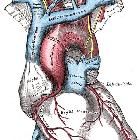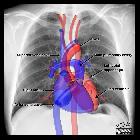common carotid artery





The common carotid artery is a paired structure that supplies blood to the head and neck.
Summary
- origin:
- left: branch of the aortic arch
- right: branch of the brachiocephalic trunk
- course: posterior to sternoclavicular joint, lateral to thyroid and trachea
- supply: head and neck
- main branches: none (usually)
- termination: at the carotid bifurcation to form the external and internal carotid arteries
- key relationships: internal jugular vein and vagus nerve
Gross anatomy
Origin and course
Although the left and right common carotid arteries follow the same course through the neck, their origin differs.
On the left, the common carotid arises directly from the aortic arch whereas, on the right, the origin is from the brachiocephalic trunk. The left common carotid artery can be thought of as having two distinct parts: thoracic and cervical. Since the right common carotid arises cranially, it only really has a cervical portion.
In the thoracic section, the left common carotid travels upwards through the superior mediastinum to the level of the left sternoclavicular joint where it is continuous with the cervical portion.
The cervical section of both common carotids follows a similar course. Each vessel passes obliquely upwards from behind the sternoclavicular joint to the level of the upper border of the thyroid cartilage. In the lower neck, the two common carotid arteries are separated from each other by the trachea. However, as the carotids ascend in the neck, they diverge becoming separated by the thyroid gland, the larynx and pharynx.
Each common carotid is contained within the carotid sheath which is derived from all 3 layers of the deep cervical fascia. In addition to containing the common carotid artery, the sheath also comprises the internal jugular vein and vagus nerve: the vein lies lateral to the artery, with the nerve in between the two. At the level of the fourth cervical vertebra, the vessel bifurcates into the external and internal carotids.
Variant anatomy
- vertebral artery arising from the CCA
- variable level of bifurcation
- left common carotid arising from brachiocephalic artery, as in a bovine arch
- hypoplastic internal or external carotid artery
- single terminal branch
- other branch arising directly from aorta
- other branch absent
- right common carotid gives rise to thyroidea ima artery
Siehe auch:
- Arteria carotis interna
- Mediastinum
- Anomalien des Aortenbogens
- Aorta
- Schilddrüse
- carotid bifurcation
- external
- internal carotids
und weiter:
- Arteria carotis externa
- Truncus bicaroticus
- Glomus caroticum Tumor
- carotid space
- Aortenbogen
- chromaffin cells
- carotid body
- Arteria carotis
- Glomus caroticum
- Arteria thyroidea ima
- persistent proatalantal intersegmental artery
- left common carotid artery originating from the brachiocephalic trunk
- Arterien von Kopf und Hals

 Assoziationen und Differentialdiagnosen zu Arteria carotis communis:
Assoziationen und Differentialdiagnosen zu Arteria carotis communis:




